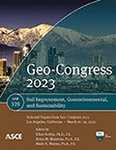Experimental Study on the Biopolymer Hydrogel Effect on Pile Driving Resistance
Publication: Geo-Congress 2023
ABSTRACT
In practice, pile foundation installation is accompanied by vibration and noise. Furthermore, structural faults along the pile may emerge if the surrounding ground has greater strength and damping than expected. Due to its sufficient strengthening and low environmental impact, biopolymer-based soil treatment (BPST) has recently been recognized as a new ground improvement technology. Because most biopolymer hydrogels have a shear thinning rheology, we conducted an experiment to see whether biopolymer hydrogels could mitigate pile penetration resistance when driving piles after installation. A pile model (40 mm in diameter × 740 mm in length) capable of measuring total resistance and tip resistance simultaneously has been fabricated for laboratory experiments. A biopolymer hydrogel spraying system, which consists of a two-way nozzle near the pile-ground interface on the surface, tubing for hydrogel transport, and a precision syringe pump for flow rate-controlled injection, has been introduced in this study. The pile model was penetrated into a pluviated sand chamber (380 mm in diameter × 900 mm in depth), with and without biopolymer hydrogel spraying during pile penetration. After pile installation tests were conducted at various times to determine when the injected biopolymer hydrogels should smear into the surrounding ground and improve pile-soil interaction. As a result, it was confirmed that the resistance to penetration of the model pile was reduced by about 17%.
Get full access to this article
View all available purchase options and get full access to this chapter.
REFERENCES
Abdel-Rahman, S. (2002). Vibration Associated with Pile Driving and its Effects on Nearby Historical Structures,# 37. Proceedings-Spie the International Society for Optical Engineering.
Bellmann, M. A. (2014). Overview of existing noise mitigation systems for reducing pile-driving noise. Proceeding auf der Internoise.
Bozyigit, I., Javadi, A., and Altun, S. (2021). Strength properties of xanthan gum and guar gum treated kaolin at different water contents. Journal of Rock Mechanics and Geotechnical Engineering, 13(5), 1160–1172.
Bruns, B., Stein, P., Kuhn, C., Sychla, H., and Gattermann, J. (2014). Hydro sound measurements during the installation of large diameter offshore piles using combinations of independent noise mitigation systems. INTER-NOISE and NOISE-CON congress and conference proceedings.
Chang, I., Im, J., Prasidhi, A. K., and Cho, G.-C. (2015). Effects of Xanthan gum biopolymer on soil strengthening. Construction and Building Materials, 74, 65–72.
Chang, I., Kwon, Y.-M., Im, J., and Cho, G.-C. (2019). Soil consistency and interparticle characteristics of xanthan gum biopolymer–containing soils with pore-fluid variation. Canadian Geotechnical Journal, 56(8), 1206–1213.
Chang, I., Lee, M., and Cho, G.-C. (2019). Global CO2 emission-related geotechnical engineering hazards and the mission for sustainable geotechnical engineering. Energies, 12(13), 2567.
Chang, I., Prasidhi, A. K., Im, J., Shin, H.-D., and Cho, G.-C. (2015). Soil treatment using microbial biopolymers for anti-desertification purposes. Geoderma, 253, 39–47.
Chen, C., Wu, L., Perdjon, M., Huang, X., and Peng, Y. (2019). The drying effect on xanthan gum biopolymer treated sandy soil shear strength. Construction and Building Materials, 197, 271–279.
Comba, S., and Sethi, R. (2009). Stabilization of highly concentrated suspensions of iron nanoparticles using shear-thinning gels of xanthan gum. Water research, 43(15), 3717–3726.
Das, B. M., and Sivakugan, N. (2018). Principles of foundation engineering. Cengage learning.
Debusschere, E., De Coensel, B., Bajek, A., Botteldooren, D., Hostens, K., Vanaverbeke, J., Vandendriessche, S., Van Ginderdeuren, K., Vincx, M., and Degraer, S. (2014). In situ mortality experiments with juvenile sea bass (Dicentrarchus labrax) in relation to impulsive sound levels caused by pile driving of windmill foundations. PloS one, 9(10), e109280.
Jaksa, M. B., Griffith, M. C., and Grounds, R. W. (2002). Ground vibrations associated with installing enlarged-base driven cast-in-situ piles. Australian Geomechanics: Journal and News of the Australian Geomechanics Society, 37(1), 67–73.
Jayawardana, P., Achuhan, R., De Silva, G. S., and Thambiratnam, D. (2018). Use of in-filled trenches to screen ground vibration due to impact pile driving: experimental and numerical study. Heliyon, 4(8), e00726.
Kastelein, R. A., Jennings, N., Kommeren, A., Helder-Hoek, L., and Schop, J. (2017). Acoustic dose-behavioral response relationship in sea bass (Dicentrarchus labrax) exposed to playbacks of pile driving sounds. Marine environmental research, 130, 315–324.
Lee, M., Im, J., Cho, G.-C., Ryu, H. H., and Chang, I. (2020). Interfacial shearing behavior along Xanthan gum biopolymer-treated sand and solid interfaces and its meaning in geotechnical engineering aspects. Applied Sciences, 11(1), 139.
Lohunova, O., and Wyjadłowski, M. (2018). Modification of vibratory driving technology for sustainable construction works. MATEC Web of Conferences.
Mansur, C. I., and Kaufman, R. I. (1956). Pile Tests, Low-Sill Structures, Old River, La. Journal of the Soil Mechanics and Foundations Division, 82(4), 1079-1071–1079-1033.
Meyerhof, G. G. (1976). Bearing capacity and settlement of pile foundations. Journal of the Geotechnical Engineering Division, 102(3), 197–228.
Moghal, A. A. B., and Vydehi, K. V. (2021). State-of-the-art review on efficacy of xanthan gum and guar gum inclusion on the engineering behavior of soils. Innovative Infrastructure Solutions, 6(2), 1–14.
Qureshi, M. U., Chang, I., and Al-Sadarani, K. (2017). Strength and durability characteristics of biopolymer-treated desert sand. Geomech. Eng, 12(5), 785–801.
Soldo, A., and Miletić, M. (2019). Study on shear strength of xanthan gum-amended soil. Sustainability, 11(21), 6142.
van der Knaap, I., Slabbekoorn, H., Moens, T., Van den Eynde, D., and Reubens, J. (2022). Effects of pile driving sound on local movement of free-ranging Atlantic cod in the Belgian North Sea. Environmental Pollution, 300, 118913.
Information & Authors
Information
Published In
History
Published online: Mar 23, 2023
Authors
Metrics & Citations
Metrics
Citations
Download citation
If you have the appropriate software installed, you can download article citation data to the citation manager of your choice. Simply select your manager software from the list below and click Download.
